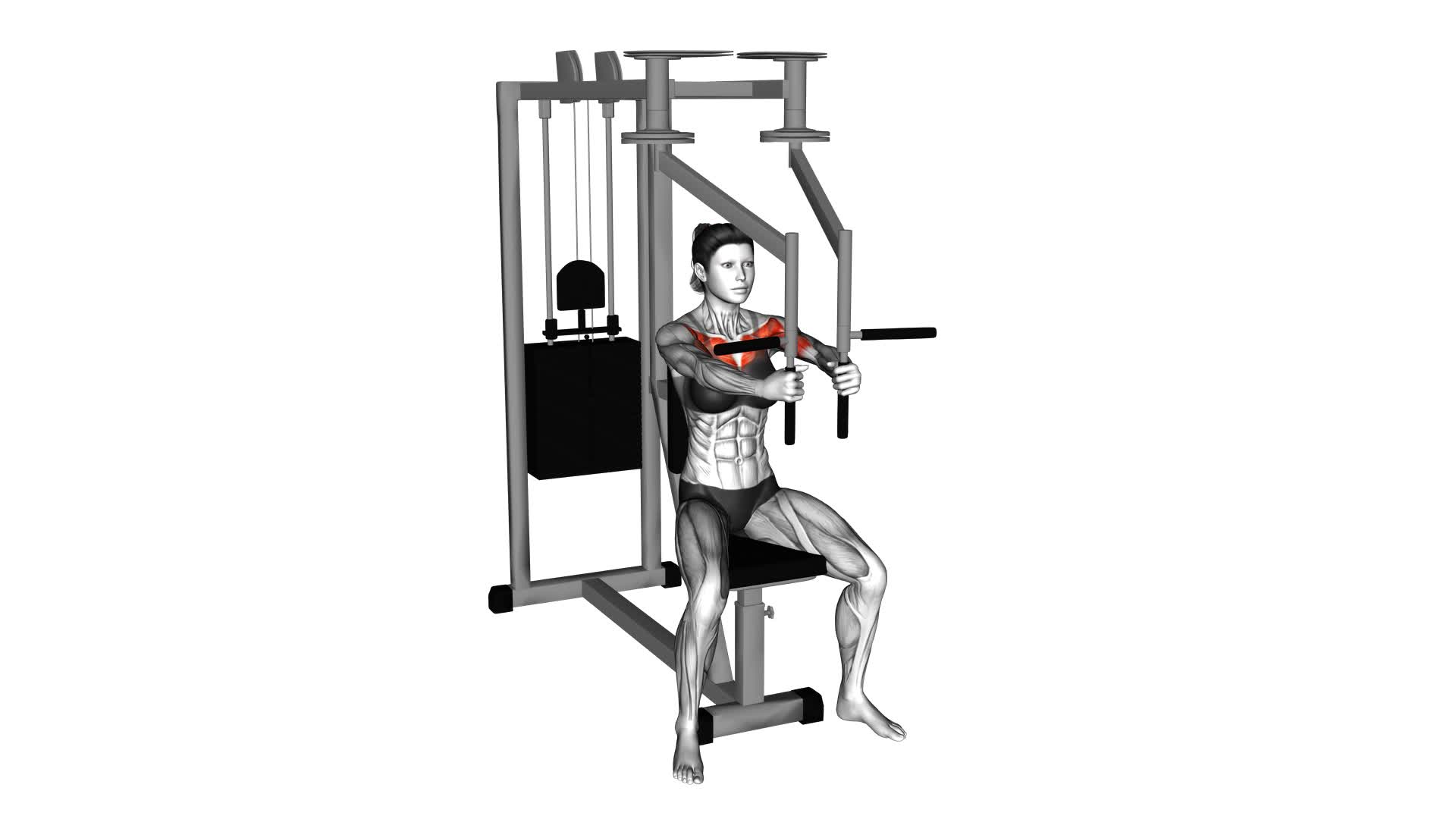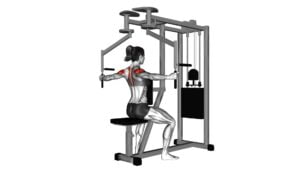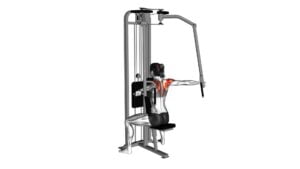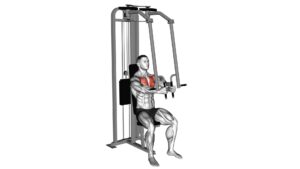Lever Seated Fly (female) – Video Exercise Guide & Tips

Are you looking to strengthen your upper body and target your chest and back muscles? The lever seated fly exercise is a great choice for women.
Watch This Exercise Video
In this video exercise guide, we'll show you the proper equipment set-up, correct form and technique, and common mistakes to avoid. Plus, we'll provide tips on how to progress and increase intensity.
Incorporate the lever seated fly into your upper body workout routine for impressive results.
Let's get started!
Key Takeaways
- The Lever Seated Fly exercise targets and strengthens the chest and upper back muscles.
- It engages the shoulder and arm muscles, improving overall muscle balance and coordination.
- The exercise helps tone and shape the chest area, enhancing upper body strength.
- Proper form and technique, along with correct hand placement, are crucial for effective targeting and optimal results.
Benefits of Lever Seated Fly for Women
Experience three key benefits of the Lever Seated Fly that specifically target and strengthen the muscles of women.
The Lever Seated Fly exercise offers numerous benefits for women, helping them enhance their overall fitness and achieve their desired physique.
Firstly, one of the main benefits of this exercise is that it targets and strengthens the muscles of the chest and upper back. By properly executing the Lever Seated Fly, women can effectively work their pectoral muscles, including the major and minor chest muscles. This helps in toning and shaping the chest area, giving a more defined and lifted appearance.
Secondly, the Lever Seated Fly also engages the muscles of the shoulders and arms. This exercise specifically targets the deltoids, which are responsible for shoulder stability and overall upper body strength. Additionally, it works the trapezius muscles, which are crucial for proper posture and preventing shoulder and neck pain.
Lastly, the Lever Seated Fly helps improve overall muscle balance and coordination. By engaging multiple muscle groups simultaneously, this exercise promotes better muscle activation and coordination, leading to improved functional movement patterns and reduced risk of injury.
To maximize the benefits of the Lever Seated Fly, it's essential to use proper technique. Maintain proper posture, engage the core muscles, and avoid excessive swinging or jerking movements. Start with lighter weights and gradually increase the resistance as strength and technique improve.
Proper Equipment Set-Up for Lever Seated Fly
Now let's move on to setting up the proper equipment for the Lever Seated Fly exercise. To ensure a safe and effective workout, follow these steps for equipment set-up:
- Adjust the seat height to a comfortable position, allowing your feet to firmly rest on the ground.
- Set the weight stack to a suitable resistance level for your fitness level and goals.
- Position yourself on the seat, ensuring that your back is fully supported by the backrest.
- Grip the handles firmly, with your palms facing each other and your elbows slightly bent.
By following these equipment set-up guidelines, you'll be able to perform the Lever Seated Fly exercise correctly and maximize its benefits. Proper hand placement is crucial for targeting the muscles effectively and minimizing the risk of injury.
Remember, the Lever Seated Fly is an excellent exercise for strengthening your back and shoulder muscles. It can help improve posture and enhance upper body strength. By understanding and implementing the proper equipment set-up, you'll be on your way to achieving your fitness goals safely and efficiently.
Correct Form and Technique for Lever Seated Fly
To ensure correct form and technique for the Lever Seated Fly, proper hand placement is crucial. Keep your hands positioned slightly wider than shoulder-width apart on the lever handles, with your palms facing each other. This grip will target your chest muscles effectively.
Additionally, be mindful of common mistakes such as using excessive momentum or allowing your shoulders to hunch forward, as these can compromise the effectiveness of the exercise.
Hand Placement Tips
Place your hands on the handles of the lever machine, ensuring a secure grip for the Lever Seated Fly exercise. Proper hand placement is crucial for maximizing the effectiveness of this exercise and preventing injury.
Here are some tips to help you achieve the correct hand placement:
- Position your hands shoulder-width apart on the handles.
- Keep your fingers wrapped around the handles, with your thumbs facing upward.
- Maintain a firm grip throughout the entire movement.
- Engage your grip strength by squeezing the handles tightly.
By following these hand placement tips, you'll be able to maintain control and stability during the Lever Seated Fly exercise. This won't only target your chest muscles effectively but also enhance your overall workout experience.
Remember to focus on form and technique to get the most out of your training session.
Common Mistakes to Avoid
One common mistake to avoid when performing the Lever Seated Fly exercise is failing to maintain proper form and technique. Incorrect hand positioning is a common error that can hinder the effectiveness of the exercise. To perform the exercise correctly, ensure that your hands are positioned correctly on the lever handles. Place your hands shoulder-width apart and grip the handles firmly.
Another mistake to avoid is a lack of stability. It's important to maintain a stable position throughout the exercise. Keep your feet flat on the ground, engage your core, and sit upright with your back against the seat. This will provide the necessary stability to execute the exercise correctly and prevent any unnecessary strain or injury.
Common Mistakes to Avoid During Lever Seated Fly
To ensure proper execution of the lever seated fly, there are a few common mistakes you should avoid.
First, make sure your seat position is correct, as sitting too far forward or backward can compromise the effectiveness of the exercise.
Secondly, check that the lever is properly adjusted to your height, allowing for a full range of motion without straining your shoulders or back.
Lastly, be mindful of maintaining a controlled and fluid range of motion throughout the exercise, avoiding jerky or incomplete movements that can lead to injury or reduced results.
Incorrect Seat Position
Sit back firmly against the seat to maintain proper alignment and stability during the Lever Seated Fly exercise. Incorrect seat position can lead to ineffective workouts and potential injury. Here are some common mistakes to avoid:
- Wrong seat height: Make sure the seat is adjusted to the appropriate height for your body. If it's too high or too low, it can put strain on your back and shoulders, compromising your form and reducing the effectiveness of the exercise.
- Uncomfortable seat position: Ensure that you're sitting in a comfortable position with your back straight and shoulders relaxed. Sitting too far forward or leaning back excessively can cause discomfort and strain on your lower back.
- Slouching: Maintain good posture throughout the exercise by avoiding slouching or rounding your shoulders. This will help engage the correct muscles and prevent unnecessary strain.
- Lack of stability: Keep your feet firmly planted on the ground and engage your core to create a stable base. This will allow you to perform the exercise with control and prevent any wobbling or imbalance.
Wrong Lever Adjustment
To ensure proper form and effectiveness during the Lever Seated Fly exercise, it's crucial to avoid making mistakes in lever adjustment.
Using improper technique in adjusting the lever can lead to an ineffective exercise that doesn't target the intended muscles effectively.
One common mistake to avoid is setting the lever too high or too low. When the lever is set too high, it can cause strain on the shoulders and limit the range of motion. On the other hand, setting the lever too low can put unnecessary stress on the chest and arms.
To avoid these issues, make sure to adjust the lever to a position that allows for a comfortable and controlled movement, ensuring that the targeted muscles are properly engaged.
Poor Range of Motion
When performing the Lever Seated Fly exercise, ensure that you maintain a full range of motion to effectively target the intended muscles. Poor range of motion can limit the effectiveness of the exercise and hinder your progress. Here are some common mistakes to avoid:
- Not fully extending your arms in the starting position
- Allowing your elbows to bend too much, reducing the stretch in your chest muscles
- Not squeezing your shoulder blades together at the end of each repetition
- Using too much weight, which can lead to compromised form and limited range of motion
If you find that you have range of motion limitations, there are alternative exercises you can try. For example, you can perform dumbbell flyes or cable flyes, which allow for a greater range of motion and target the same muscle groups. Remember to always prioritize maintaining proper form and full range of motion during your workouts.
Transitioning to the next section, let's explore how to progress and increase intensity with the lever seated fly.
How to Progress and Increase Intensity With Lever Seated Fly
To progress and increase intensity with the lever seated fly, you can gradually add more resistance and focus on maintaining proper form throughout the exercise. Increasing resistance can be done by adjusting the weight on the lever machine. Start with a weight that challenges you but still allows you to complete the exercise with proper form. As you become stronger and more comfortable, gradually increase the weight to continue challenging your muscles.
In addition to increasing resistance, you can also focus on other aspects to intensify the exercise. One way is to slow down the tempo of the movement, emphasizing the eccentric (lowering) phase of the exercise. This will increase the time under tension and further engage your muscles. Another way to increase intensity is by incorporating pauses at the bottom of the movement. This will increase the difficulty of the exercise and require more muscle activation to initiate the movement.
Remember to always prioritize proper form over adding more weight or intensity. Maintaining correct posture, keeping your back straight, and engaging your core will ensure that you target the intended muscle groups effectively and minimize the risk of injury.
Now that you know how to progress and increase intensity with the lever seated fly, let's move on to the next section where we'll discuss tips for incorporating this exercise into your upper body workout routine.
Tips for Incorporating Lever Seated Fly Into Your Upper Body Workout Routine
To incorporate the lever seated fly into your upper body workout routine, you can start by adjusting the weight on the lever machine to challenge your muscles while maintaining proper form. Here are some tips to help you make the most out of this exercise:
- Experiment with different hand placements: Try placing your hands closer together or wider apart on the machine handles to target different areas of your chest and shoulders. This variation can help you engage different muscle fibers and promote overall muscle development.
- Focus on proper form: Keep your back straight and your core engaged throughout the movement. Avoid using momentum or swinging your body to lift the weights. Slow and controlled movements will maximize the benefits and minimize the risk of injury.
- Pair it with other upper body exercises: Incorporate the lever seated fly into a well-rounded upper body workout routine by combining it with other exercises such as push-ups, shoulder presses, or chest presses. This will ensure that you're targeting all the major muscle groups in your upper body.
- Consider alternative exercises: While the lever seated fly is an effective exercise, it's always beneficial to mix up your routine. Incorporate other exercises such as dumbbell flyes, cable crossovers, or chest dips to provide variety and challenge your muscles in different ways.
Frequently Asked Questions
How Many Sets and Reps Should I Do for Lever Seated Fly?
For the lever seated fly exercise, it's recommended to start with 3 sets of 8-12 reps. This will help you build strength and muscle in your chest and shoulders.
However, as you progress, you can increase the number of sets and reps to challenge yourself further.
If you're looking for variations, you can try different grip positions or use different machines that target the same muscle groups.
Alternatively, you can also explore alternative exercises like cable flies or dumbbell flies.
Can Lever Seated Fly Help in Reducing Back Fat?
Lever seated fly is a great exercise for targeting your back muscles. However, it may not specifically reduce back fat. To achieve overall fat loss, a combination of cardiovascular exercise, strength training, and a healthy diet is recommended.
However, lever seated fly variations can be incorporated into a full body workout routine to help strengthen your back and improve your overall physique. Consider combining lever seated fly with other exercises like rows, pull-ups, and planks for a well-rounded workout.
Is Lever Seated Fly Suitable for Beginners?
Lever seated fly is a great exercise for beginners. It targets your back muscles, helping to strengthen and tone them.
To perform the exercise with proper form and technique, sit on the lever machine with your feet flat on the ground and your back straight.
Grab the handles and bring them together in front of you, squeezing your shoulder blades.
As a beginner, you can start with lighter weights and gradually increase as you get stronger.
Remember to consult a trainer for modifications and variations to suit your fitness level.
Can Lever Seated Fly Help in Improving Posture?
Yes, the lever seated fly can help improve your posture. By targeting the muscles in your back and shoulders, this exercise can strengthen the muscles responsible for maintaining good posture.
Incorporating variations of the lever seated fly into your routine, such as using heavier weights or performing more reps, can challenge advanced lifters.
Additionally, adding the lever seated fly to a full body workout routine offers the benefits of increased upper body strength and improved overall muscle balance.
What Muscles Does Lever Seated Fly Target?
The lever seated fly targets several muscles in your upper body. It primarily works your chest muscles, specifically the pectoralis major and minor. Additionally, it also engages your shoulder muscles, specifically the anterior deltoids.
Incorporating variations of the lever seated fly into your workout routine can provide advanced lifters with new challenges and help enhance muscle growth and strength.
Moreover, adding this exercise to a full upper body workout routine can contribute to overall upper body development and improved strength.
Conclusion
Incorporating the lever seated fly into your upper body workout routine can provide numerous benefits for women.
By using the proper equipment set-up and maintaining correct form and technique, you can target your chest and shoulders effectively.
Avoiding common mistakes and gradually increasing intensity will help you progress in your fitness journey.
Remember to consult with a professional trainer for personalized guidance and to ensure safety during your workouts.

Author
Years ago, the spark of my life’s passion ignited in my mind the moment I stepped into the local gym for the first time. The inaugural bead of perspiration, the initial endeavor, the very first surge of endorphins, and a sense of pride that washed over me post-workout marked the beginning of my deep-seated interest in strength sports, fitness, and sports nutrition. This very curiosity blossomed rapidly into a profound fascination, propelling me to earn a Master’s degree in Physical Education from the Academy of Physical Education in Krakow, followed by a Sports Manager diploma from the Jagiellonian University. My journey of growth led me to gain more specialized qualifications, such as being a certified personal trainer with a focus on sports dietetics, a lifeguard, and an instructor for wellness and corrective gymnastics. Theoretical knowledge paired seamlessly with practical experience, reinforcing my belief that the transformation of individuals under my guidance was also a reflection of my personal growth. This belief holds true even today. Each day, I strive to push the boundaries and explore new realms. These realms gently elevate me to greater heights. The unique combination of passion for my field and the continuous quest for growth fuels my drive to break new ground.



